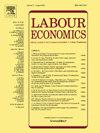部分退休机会和老年人的劳动力供给
IF 2.6
2区 经济学
Q2 ECONOMICS
引用次数: 0
摘要
我们评估部分退休选择作为一种工具,以增加劳动参与的老年人。在一项明确的选择实验中,荷兰的调查受访者被要求在提前退休、推迟退休和部分退休(不受兼职工作限制)和逐步退休之间做出选择。退休情景特征是随机化的,产生了丰富的选择选项。使用关于(计划的)退休决策的显示的偏好数据验证所述的选择。使用陈述的选择数据,我们估计了一个模型,使闲暇和收入之间的权衡在生命周期中明确,并使用估计模型反事实的政策模拟。我们发现,正如预期的那样,更高的(全额)养老金资格年龄使精算上公平的(突然的)提前退休更具吸引力,而使延迟退休更具吸引力,而大约三分之一的受访者更喜欢部分退休,而不管资格年龄如何。当个人没有部分退休选择时,提前退休比晚退休更有吸引力。此外,部分退休决策对财政激励很敏感,因此用更高的工资补贴部分退休,或者用超过精算公平的养老金增长来推迟退休,会增加总劳动力供给。这些发现表明,部分退休作为刺激劳动力参与的政策工具的潜力,特别是在养老金资格推迟的情况下。本文章由计算机程序翻译,如有差异,请以英文原文为准。
Partial retirement opportunities and the labor supply of older individuals
We evaluate partial retirement options as an instrument to increase labor participation among older individuals. In a stated choice experiment, Dutch survey respondents were asked to choose among early, late and partial retirement scenarios purged from restrictions on part-time work and gradual retirement. Retirement scenario characteristics were randomized, generating rich variation in the choice options. The stated choices are validated using revealed preference data on (planned) retirement decisions. Using the stated choice data, we estimate a model that makes the trade-offs between leisure and income over the life cycle explicit, and use the estimated model for counterfactual policy simulations. We find that, as expected, higher (full) pension eligibility ages make actuarially fair (abrupt) early retirement more attractive and make late retirement less attractive, while about one in three respondents prefer partial retirement irrespective of the eligibility age. Early retirement becomes more attractive than late retirement when individuals do not have the partial retirement option. Moreover, the partial retirement decision is sensitive to financial incentives so that subsidizing partial retirement with higher wages or with more than actuarially fair pension increases for delaying retirement increases total labor supply. These findings demonstrate the potential of partial retirement as a policy instrument to stimulate labor participation, especially when pension eligibility is delayed.
求助全文
通过发布文献求助,成功后即可免费获取论文全文。
去求助
来源期刊

Labour Economics
ECONOMICS-
CiteScore
3.60
自引率
8.30%
发文量
142
期刊介绍:
Labour Economics is devoted to publishing research in the field of labour economics both on the microeconomic and on the macroeconomic level, in a balanced mix of theory, empirical testing and policy applications. It gives due recognition to analysis and explanation of institutional arrangements of national labour markets and the impact of these institutions on labour market outcomes.
 求助内容:
求助内容: 应助结果提醒方式:
应助结果提醒方式:


